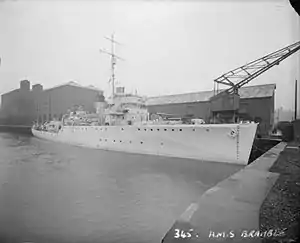 HMS Bramble, April 1942 | |
| History | |
|---|---|
| Name | HMS Bramble |
| Ordered | 11 August 1937 |
| Builder | HM Dockyard, Devonport |
| Laid down | 22 November 1937 |
| Launched | 12 July 1938 |
| Commissioned | 22 June 1939 |
| Honours and awards | Arctic 1941–42 |
| Fate | Sunk, 31 December 1942 |
| Badge | On a Field White, a Bramble, slipped and leaved Proper |
| General characteristics [1] | |
| Class and type | Halcyon-class minesweeper |
| Displacement | |
| Length | 245 ft 9 in (74.90 m) o/a |
| Beam | 33 ft 6 in (10.21 m) |
| Draught | 9 ft (2.7 m) |
| Propulsion |
|
| Speed | 16.5 knots (30.6 km/h; 19.0 mph) |
| Range | 7,200 nmi (13,300 km; 8,300 mi) at 10 kn (19 km/h; 12 mph) |
| Complement | 121 |
| Armament |
|
HMS Bramble was a Halcyon-class minesweeper (officially, "fleet minesweeping sloop") of the Royal Navy, which was commissioned in 1939, just prior to World War II. During the war she served as a minesweeper in the North Sea, and then on Russian convoys until sunk in the Battle of the Barents Sea on 31 December 1942 by the German cruiser Admiral Hipper and the destroyer Friedrich Eckoldt.
Service history
The ship was ordered on 11 August 1937 from HM Dockyard Devonport, with engines supplied by Barclay Curle. She was laid down on 22 November 1937, and launched on 12 July 1938. After sea trials in July 1939 Bramble was assigned to the 1st Minesweeping Flotilla at Portland Harbour, sailing with the Flotilla to Scapa Flow in August. She served as a minesweeper in the North Sea until February 1941, when she transferred to Harwich for operations in the Thames Estuary.[2]
In April 1941 she was transferred to Western Approaches Command for Atlantic convoy escort duty, and attached to the 3rd Escort Group. Between 22 July 1941 and 16 November 1942 she was commanded by Captain John Crombie.[3] In October she was detached to serve on the Russian convoys, and joined Convoy PQ 2 sailing to Arkhangelsk, where she remained carrying out local minesweeping and patrol duties, as well as escorting in- and out-bound convoys. She returned to the UK in January 1942 to be refitted at a yard in Sunderland. She returned to convoy duty in April, returning to Russia with Convoy PQ 15. She served there until October, when she returned to the UK to be repaired at a shipyard in the Humber.
Sinking
On 22 December 1942 Bramble sailed with Convoy JW 51B from Loch Ewe. The convoy was sighted by the German submarine U-354 on 30 December and the German cruisers Admiral Hipper and Lützow, accompanied by six destroyers, sailed from Altenfjord to intercept them in Operation Regenbogen,[2] leading to the Battle of the Barents Sea. On 31 December Bramble, which had been detached to search for stragglers, was returning to the convoy when she encountered Admiral Hipper and three destroyers. Hipper promptly opened fire with her 8 in (200 mm) guns. Bramble returned fire but was overwhelmed and finally sunk with all hands by the destroyer Friedrich Eckoldt in position 73°18′N 30°06′E / 73.300°N 30.100°E.[2]
Convoys
Bramble served on the following convoys between the UK and Russia, prefixed PQ, with returning convoys prefixed QP:[4]
| Convoy | Dates |
|---|---|
| PQ 2 | 17–30 October 1941 |
| QP 2 | 3–5 November 1941 |
| PQ 3 | 20–22 November 1941 |
| QP 3 | 27–28 November 1941 |
| PQ 5 | 7–13 December 1941 |
| QP 4 | 29 December 1941 – 5 January 1942 |
| QP 6 | 25–28 January 1942 |
| PQ 15 | 26 April–5 May 1942 |
| QP 12 | 21–23 May 1942 |
| PQ 16 | 28–30 May 1942 |
| QP 13 | 26–28 June 1942 |
| QP 14 | 13–25 September 1942 |
| JW 51B | 22–31 December 1942 |
References
- ↑ "Halcyon Minesweepers : Specifications". halcyon-class.co.uk. 2011. Retrieved 4 March 2012.
- ↑ Griffths, David. "HMS Bramble Crew". Halcyon class Minesweepers and Survey Ships of World War Two. Retrieved 20 May 2012.
- ↑ Hague, Arnold (2007). "Convoy database". convoyweb.org.uk. Retrieved 4 March 2012.
External links
- "Allied Warships of WWII – Minesweeper HMS Bramble". uboat.net.
- "HMS Bramble : Halcyon Minesweeper". halcyon-class.co.uk.
- "Bramble Minesweeper 1937–1942". wrecksite.eu.